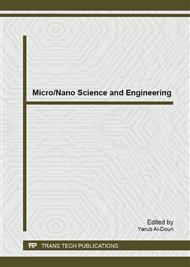p.455
p.460
p.464
p.469
p.474
p.481
p.486
p.490
p.495
Development of Hybrid WO3-TiO2 Nanotubes for Solar Hydrogen Generation via Water Electrolysis
Abstract:
Solar hydrogen (H2) generation from water electrolysis is a key target for the development of sustainable hydrogen economy for future energy system. The formation of self-organized and highly ordered titania (TiO2) nanotubes is essential for high efficiency in photoelectrochemical (PEC) water electrolysis application. Based on our preliminary studies, highly ordered TiO2 nanotubes were successfully synthesized through anodization of titanium (Ti) foil in ethylene glycol (EG) containing 5 wt% of ammonium fluoride (NH4F) and 5 wt% of hydrogen peroxide (H2O2) at 60 V for 1 h. However, an obvious hindrance to the widespread use of TiO2 nanotubes as a photoelectrode in PEC water electrolysis system is its poor visible light response and rapid recombination of photo-induced electron/hole pairs. Thus, continuous efforts have been exerted to improve the efficiency of PEC water electrolysis by incorporating an optimum content of W6+ species into TiO2 nanotubes. In the present study, a practical technique of radio frequency (RF) sputtering was selected to incorporate W6+ species into TiO2 lattice. It was found that TiO2 nanotubes sputtered at high energy of 50 W for 30 sec demonstrated a maximum photocurrent density of ~ 2.4 mA/cm2 with photoconversion efficiency ~ 6 %.
Info:
Periodical:
Pages:
474-478
Citation:
Online since:
April 2014
Authors:
Price:
Сopyright:
© 2014 Trans Tech Publications Ltd. All Rights Reserved
Share:
Citation:



